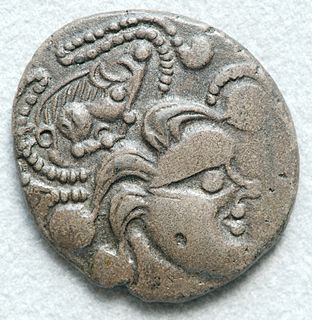Related Research Articles

The Taurini were a Celto-Ligurian tribe dwelling in the upper valley of the river Po, around present-day Turin, during the Iron Age and the Roman period.
The Viducasses were a Gallic tribe dwelling in the modern Calvados department during the Iron Age and the Roman period.
The Oxybii or Oxubii were a Celto-Ligurian tribe dwelling on the Mediterranean coast during the Iron Age and the Roman period.

The Bodiocasses or Baiocasses were an ancient Gallic tribe of the Roman period. They were a tribal division of the civitas of the Lexovii, in the Roman province of Gallia Lugdunensis.
The Alauni were a Gallic tribe dwelling around Chiemsee (Bavaria) during the Roman period.
The Latobici or Latovici were a Celtic tribe dwelling in Pannonia Superior, around present-day Drnovo (Slovenia), during the Roman period.
The Veliocasses were a Belgic or Gallic tribe of the La Tène and Roman periods, dwelling in the south of modern Seine-Maritime and in the north of Eure.

The Vindelici were a Gallic people dwelling around present-day Augsburg (Bavaria) during the Iron Age and the Roman period.
The Vediantii were a Celto-Ligurian tribe dwelling on the Mediterranean coast, near present-day Nice, during the Iron Age and the Roman period.
The Ingauni were a Celto-Ligurian tribe dwelling on the Mediterranean coast, around the modern city of Albenga (Liguria), during the Iron Age and the Roman period.
The Nemeturii or Nemeturi were a Gallic tribe dwelling in the Alpes Maritimae during the Iron Age.
The Venisami or Venisamores were a Gallic tribe dwelling in the Alps during the Iron Age.
The Ambisontes were a Gallic tribe dwelling in the upper Salzach valley during the Roman period.
The Vennones or Vennonetes were a Gallic or Rhaetian tribe dwelling in the northern Alps, between Chur and Lake Constance, during the Iron Age and the Roman era.
The Rucinates or Rucantii were a Gallic tribe dwelling in near the confluence of the Isar and Danube rivers during the Roman period.
The Genauni or Genaunes were a Gallic tribe dwelling in the eastern valley of the Inn river, in Tyrol, during the Iron Age and the Roman period.
The Ambilici were a Gallic tribe dwelling in the valley of Gail river during the Roman period.
The Licates were a Gallic tribe dwelling in the upper valley of the Lech river during the Iron Age and the Roman period.
The Ligauni were a Celto-Ligurian tribe dwelling near the Mediterranean coast during the Iron Age and the Roman period.
The Brixentes or Brixenetes were a Gallic tribe dwelling at the confluence of the Eisack and Rienz rivers, near present-day Brixen, during the Iron Age and the Roman era.
References
- 1 2 Pliny. Naturalis Historia, 3:20.
- 1 2 Falileyev 2010, s.v. Cat(t)enates.
- ↑ Evans 1967, p. 174.
- ↑ de Bernardo Stempel 2015, p. 91.
- ↑ Talbert 2000, Map 12: Mogontiacum-Reginum-Lauriacum.
- ↑ Schumacher, Dietz & Zanier 2007.
Primary sources
- Pliny (1938). Natural History. Loeb Classical Library. Translated by Rackham, H. Harvard University Press. ISBN 978-0674993648.
Bibliography
- de Bernardo Stempel, Patrizia (2015). "Zu den keltisch benannten Stämmen im Umfeld des oberen Donauraums". In Lohner-Urban, Ute; Scherrer, Peter (eds.). Der obere Donauraum 50 v. bis 50 n. Chr. Frank & Timme. ISBN 978-3-7329-0143-2.
- Evans, D. Ellis (1967). Gaulish Personal Names: A Study of Some Continental Celtic Formations. Clarendon Press. OCLC 468437906.
- Falileyev, Alexander (2010). Dictionary of Continental Celtic Place-names: A Celtic Companion to the Barrington Atlas of the Greek and Roman World. CMCS. ISBN 978-0955718236.
- Schumacher, Stefan; Dietz, Karlheinz; Zanier, Werner (2007). "Vindeliker". In Beck, Heinrich (ed.). Reallexikon der Germanischen Altertumskunde. 35 (2 ed.). De Gruyter. ISBN 978-3110187847.
- Talbert, Richard J. A. (2000). Barrington Atlas of the Greek and Roman World. Princeton University Press. ISBN 978-0691031699.
